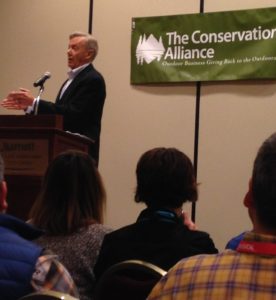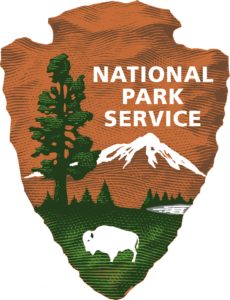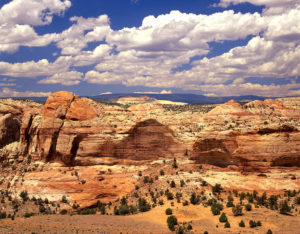 Utah and Bruce Babbitt have a history.
Utah and Bruce Babbitt have a history.
In the 1990s, when he led efforts to designate nearly two million acres of the Grand Staircase Escalante area as a National Monument, folks here hung him in effigy.
How foul was the vibe?
The ceremony had to take place across the border in Arizona. The former Arizona governor helped set aside a record 21 such designations during his tenure as President Bill Clinton’s Secretary of the Interior.
But at the Conservation Alliance breakfast, held before a full house in a Marriot Hotel ballroom during the Outdoor Retailer Market, Babbitt was among friends. He received a standing ovation before AND after his talk.
And he used these cozy quarters to lambast Governor Herbert as well as Utah’s land-grabbing legislative efforts, better known as H.B. 148 “Transfer of Public Lands Act and Related Study.”
“The real reason for this [transfer legislation] is to provide a conduit by which the public lands of this state can be transferred to Utah in order to be served up to coal, oil and gas, and mineral industries for exploitation,” he said.
In addition, he spoke scathingly of the 784-page study of the proposed land transfer, conducted by the University of Utah, Weber State University, and Utah State University”
“This movement right now is kind of being dressed up with a bunch of universities and academics making metrics and economic arguments,” he said.
 In fact, The report does address the impact on outdoor recreational interests with the exact statistics used by Babbitt: According to the Outdoor Industry Association, it’s a $645 billion annual industry, growing five percent annually. It’s bigger than pharmaceuticals, motor vehicles, and gas industries, it said. Read the report here.
In fact, The report does address the impact on outdoor recreational interests with the exact statistics used by Babbitt: According to the Outdoor Industry Association, it’s a $645 billion annual industry, growing five percent annually. It’s bigger than pharmaceuticals, motor vehicles, and gas industries, it said. Read the report here.
The authors, for example, considered a specific economic model to calculate the potential Willingness to Pay (WTP) losses if there were more oil development on elk-hunting land. Essentially, folks pay huge money to hunt trophy elk in pristine wilderness. If industry comes in, stirs up the elk population and wrecks the panoramic photo opportunities, the WTP goes down. Hunters go elsewhere.
The report also noted key findings of a 2007 statewide survey addressing quality of life, outdoor recreation, and public land access. To note:
- Folks move here for the “natural amenities” of public lands and protected landscapes.
- Those conditions are directly connected to “local economic well-being, including in particular income levels, income growth, and employment growth.”
In other words, people who move here aren’t slackers, living out of their cars, camping on BLM land, and cooking up ramen night after night. They’re smart, go-getters who contribute significantly to the economy:
“[They] tend to be highly educated and employed in skilled and professional occupations [which] can cause such areas to exhibit enhanced levels of “human capital.”
It’s true, though, the bulk of the report is dedicated to expected mineral leases, mining sales, timber, gas and coal development and the gains therein.
 Babbitt, 76, compared the recent land transfer movement to the Sagebrush Rebellion of the 1970-80s, in which several western states’ citizens and politicians lobbied (sometimes violently) for state entitlement to federal land. The federal government owns 96 percent of Alaska, 81 percent of Nevada, 66 percent of Utah, 64 percent of Idaho, 53 percent of Oregon, and 48 percent of Wyoming.
Babbitt, 76, compared the recent land transfer movement to the Sagebrush Rebellion of the 1970-80s, in which several western states’ citizens and politicians lobbied (sometimes violently) for state entitlement to federal land. The federal government owns 96 percent of Alaska, 81 percent of Nevada, 66 percent of Utah, 64 percent of Idaho, 53 percent of Oregon, and 48 percent of Wyoming.
But now, he said, this new Sagebrush Rebellion is sponsored by energy companies and special interest groups which funnel torrents of cash to politicians.
“It’s a new crowd of players. We think of Cliven Bundy and those sorts as being the face of this Sagebrush Rebellion. But this is different. They’re pushing those guys off the stage. They’re bringing in really sophisticated actors.”
What’s the outdoor industry to do?
- Fight fire with fire, he said.
The outdoor recreation industry, though not as established or coalesced as the mining and timber industries, is a $646 billion a year industry supporting more than six million jobs, according to the Center for American Progress.But it’s a “sleeping giant,” said Babbitt.If the Patagonia’s and REI’s of the world want to safeguard wilderness for their customers, they best organize and start flexing their money, lobbying, and advocacy muscles. He urged the audience to seek recognition as an economic sector by the U.S. Commerce Department.
- Get young people involved. As the country continues its trend toward urbanization, get creative in how you
 reach city folks and motivate them to recreate in the outdoors.
reach city folks and motivate them to recreate in the outdoors.
- Next year, the National Park Service will celebrate its centennial. Make the most of it.
“Turn that into a celebration of public lands and the potential for public lands,” he said. “You’ve got the chance to really make a difference to protect the resources that are the base of your entire industry. This is the moment to come together and stand tall.”

Terrific article-thanks. Babbit, is as usual, right on the money. Obvious but eloquently stated that outdoor recreation/tourism can be sustainable, coal mine cannot.
I’d only quibble with the phrase “reclamation” of federal land. It was never owned by the states so how can it be “reclaimed”? Until the western states can show some responsible stewardship of public resources, their role in management of land that is equally the property of everyone in the USA should be kept to a bare minimum. Way too much Clive Bundy attitude abounds.
Thanks, Steve. You’re right. Reclamation is inappropriate and somehow survived my edit. Change made. As for Clive Bundy: as I see it he’s the tip of the iceberg and as such probably won’t sway more than the social media and TV crowd (he gets as much disdain as sympathy out here). The real threat is from the post Citizen United crowd and strategies. Dark money.
Terrific article-thanks. Babbit, is as usual, right on the money. Obvious but eloquently stated that outdoor recreation/tourism can be sustainable, coal mine cannot.
I’d only quibble with the phrase “reclamation” of federal land. It was never owned by the states so how can it be “reclaimed”? Until the western states can show some responsible stewardship of public resources, their role in management of land that is equally the property of everyone in the USA should be kept to a bare minimum. Way too much Clive Bundy attitude abounds.
Thanks, Steve. You’re right. Reclamation is inappropriate and somehow survived my edit. Change made. As for Clive Bundy: as I see it he’s the tip of the iceberg and as such probably won’t sway more than the social media and TV crowd (he gets as much disdain as sympathy out here). The real threat is from the post Citizen United crowd and strategies. Dark money.